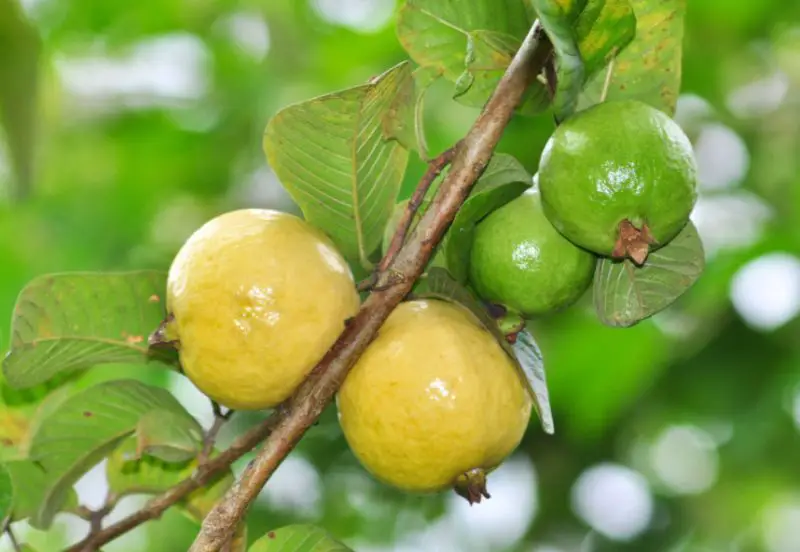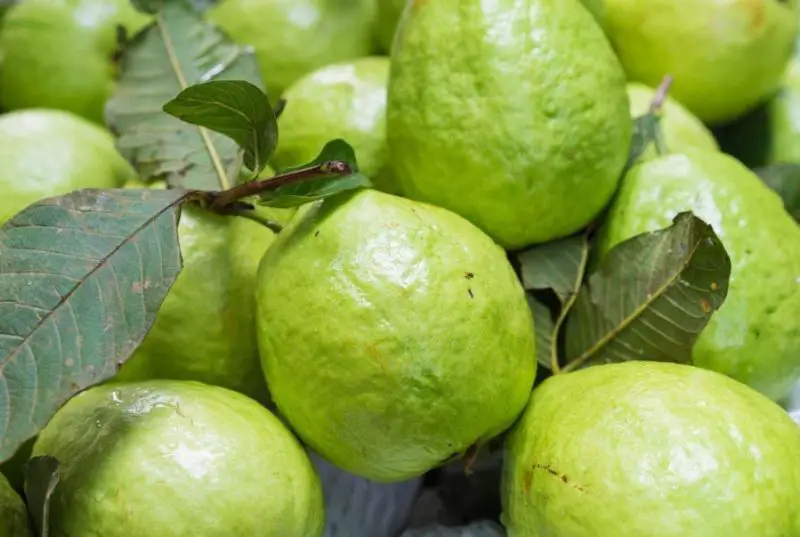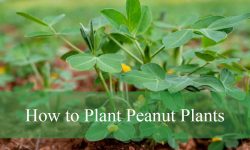Guava fruit trees, with their lush foliage and delicious fruit, are a delightful addition to any garden or orchard.
Whether you are a seasoned gardener or just starting out on your fruit growing journey, understanding the characteristics, growing, and taking care of this fruit tree can ensure a bountiful harvest and that the garden flourishes.
In this article, we’ll explore everything you need to know about growing and caring for guava trees, from choosing the right variety to harvesting the ripe fruit. Let’s discover the secret to successfully growing this tropical treasure.
About Guava Fruit Tree

The guava fruit tree is a small yet robust plant that thrives in tropical and sub-tropical climates. With its wide, short canopy and sturdy trunk, the guava tree is not only a fruitful addition to any garden but also an aesthetically pleasing one.
Guava trees feature mottled greenish bark and long, serrated leaves that range from 3 to 7 inches in length. They produce small, white flowers about 1 inch in diameter, which eventually turn into round, oval, or pear-shaped fruits. These fruits, technically classified as berries, have soft flesh that can vary in color from white, pink, yellow, to red. The taste of guava fruit ranges from acidic and sour to sweet and rich, depending on the variety.
Optimal Growing Conditions for Guava Fruit Tree
Soil
Guava plants are highly adaptable and can thrive in a variety of soil types, provided that the soil has good drainage. Whether planted in sandy, loamy, or even slightly clayey soils, guava trees can flourish as long as excess water can escape easily, preventing waterlogging, which can damage the roots. This flexibility extends to their tolerance of soil pH levels; guavas are not particularly picky and can grow well in soils that range from slightly acidic to neutral.
Sunlight
Full sun is essential for the best flowering and fruit production in guava plants. To ensure your guava tree thrives, it needs at least 6 to 8 hours of direct sunlight daily. Adequate sunlight promotes healthy growth, enhances the tree’s ability to produce abundant flowers, and ultimately results in a more bountiful harvest of delicious fruit.
Planting your guava tree in a location where it can receive uninterrupted sunlight throughout the day will maximize its growth potential and fruiting capabilities. This optimal sun exposure is a critical factor in the successful cultivation of guava trees.
Watering
Regular watering is crucial for guava trees, especially during their establishment phase. In the first year after planting, it’s important to keep the soil consistently moist to help the young tree develop a strong root system. As the tree matures, it becomes somewhat drought-tolerant, but maintaining consistent moisture levels will result in better yields and healthier growth.
While guava trees appreciate regular watering, it’s essential to avoid waterlogging, as excessive moisture can damage the roots and lead to issues such as root rot. Striking the right balance when watering will ensure your guava tree remains vigorous and productive.
Temperature
Guava trees thrive in warm climates and are sensitive to cold temperatures, requiring protection in cooler regions. They are not suitable for outdoor growth in areas where frost is frequent, as exposure to freezing temperatures can damage or even kill the tree.
In colder climates, it’s advisable to grow guava trees in containers that can be easily moved indoors during the winter months. This allows you to provide the necessary protection from frost and cold snaps, ensuring the survival and health of your guava tree.
Fertilization
Fertilization plays a crucial role in supporting the growth and fruit production of guava trees. It’s recommended to use a balanced fertilizer to provide the necessary nutrients for optimal development. Guava trees benefit from regular fertilization, particularly during the growing season when they have increased nutrient demands.
To ensure healthy growth and abundant fruiting, fertilize your guava tree three to four times a year. Applying fertilizer at strategic times helps replenish the soil with essential nutrients, promoting vigorous growth, strong root development, and prolific fruit production.
For maximum fruit production, guava trees require high levels of nitrogen, phosphoric acid, and potash in addition to a small amount of magnesium. For instance, a 6-6-6-2 formula can be mixed into the soil shortly before the growing season begins, and it can then be evenly spaced out three times while the plant is growing.
Planting and Caring for Guava Fruit Tree

Planting
When planting guava trees, selecting the right location is paramount to their success. Choose a spot that receives full sun throughout the day, as sunlight is essential for the tree’s growth, flowering, and fruit production. Additionally, ensure the soil is well-drained to prevent waterlogging, which can be detrimental to the tree’s roots.
If planting multiple guava trees, space them at least 10 feet apart to provide ample room for each tree to grow and spread its branches. Proper spacing allows for adequate air circulation, reduces competition for nutrients and sunlight, and helps prevent overcrowding as the trees mature.
Pruning
Regular pruning is an essential practice for maintaining the health and vigor of guava trees. By removing dead, damaged, or diseased branches, you not only improve the tree’s appearance but also prevent the spread of pathogens and encourage healthy growth.
When pruning guava trees, focus on shaping the canopy to maintain an open structure that allows for better air circulation and sunlight penetration. Thin out crowded areas to reduce competition among branches and encourage the development of strong, productive limbs. This also helps prevent the onset of fungal diseases and pest infestations by improving airflow throughout the tree.
Additionally, prune any crossing or rubbing branches to prevent them from damaging each other and inhibiting growth. You can encourage vigorous new growth, improve fruit output, and maintain the long-term health and productivity of your guava tree by trimming it on a regular basis.
Pest and Disease Control
Effective pest and disease control is crucial for maintaining the health and productivity of guava trees. Keep a vigilant eye out for common pests such as fruit flies, aphids, and scale insects, which can cause damage to foliage and fruit if left unchecked.
Implementing both preventive and responsive measures is key to managing pests and diseases effectively. Consider using organic or chemical treatments when necessary to control pest infestations and prevent them from causing significant damage to the tree. However, be mindful of using chemical treatments and opt for organic alternatives whenever possible to minimize environmental impact.
In addition to pest control, good sanitation practices are essential for preventing the spread of diseases. Regularly remove fallen fruit, leaves, and other debris from around the tree, as these can harbor pathogens and provide breeding grounds for pests.
Cold Protection
In regions where occasional frost poses a threat to guava trees, it’s essential to implement measures to protect them from freezing temperatures. One effective method is to use frost cloths or blankets to cover the trees during periods of cold weather. These protective covers help trap heat close to the tree, creating a microclimate that mitigates the impact of frost and prevents damage to sensitive foliage and fruit.
For guava trees grown in containers or pots, another option is to bring them indoors during cold spells. Placing potted trees in a sheltered location, such as a garage or greenhouse, provides them with the warmth and protection they need to withstand freezing temperatures. Be sure to acclimate the trees gradually to indoor conditions to minimize stress and shock.
Growing guava fruit tree from seed
Growing guava from seed can be a rewarding but patience-testing endeavor. Unlike some fruit trees, guava seeds may not yield a fruit-bearing tree for several years, often taking up to eight years to reach maturity. Additionally, it’s important to note that guava plants grown from seeds are not true to the parent plant, meaning their characteristics may vary significantly.
While cuttings and layering are more commonly used propagation methods for guava trees due to their reliability, growing guava seeds can still be a fun and interesting project. To get started, you’ll need to harvest seeds from a fresh guava fruit and remove the flesh by soaking them. The seeds can remain viable for several months, but germination may take patience, often requiring up to eight weeks.
To improve germination rates, it’s recommended to boil the seeds for about five minutes before planting. This process softens the tough outer seed coat, making it easier for the seedling to emerge.
Common guava varieties in North America
Common guava varieties in North America include:
American Guava (Psidium guajava)
The American Guava, scientifically known as Psidium guajava, or commonly referred to as Common Guava, is the predominant variety grown in numerous warm regions across North America. Renowned for its adaptability and productivity, this variety thrives in climates conducive to tropical and subtropical fruit cultivation.
Its fruits are prized for their delightful sweetness and distinct aroma, making them a popular choice among growers and consumers alike. Whether enjoyed fresh, juiced, or incorporated into various culinary creations, the American Guava remains a beloved fruit cherished for its delicious flavor and versatility.
Strawberry Guava (Psidium cattleianum)
Strawberry Guava, scientifically known as Psidium cattleianum, is a delightful variety often referred to as Cherry Guava due to its resemblance to cherries in appearance and flavor. Renowned for its sweet and tangy taste reminiscent of strawberries, this guava variety is highly sought after by fruit enthusiasts.
It thrives in warm climates and is particularly well-suited for cultivation in tropical and subtropical regions. With its charming flavor and versatility, Strawberry Guava is a beloved choice for both fresh consumption and culinary applications, adding a unique twist to a variety of dishes and beverages.
Feijoa (Feijoa sellowiana)
Feijoa, scientifically referred to as Feijoa sellowiana and commonly known as Pineapple Guava, is a popular fruit tree cultivated in warm and humid regions. Renowned for its attractive appearance and delightful flavor, Feijoa produces fruits with a unique combination of sweet and tart tastes, reminiscent of pineapple.
Its distinct aroma further adds to its appeal, with a fragrance that evokes tropical sensations. Often used fresh or in various culinary applications, Feijoa is cherished by growers and consumers alike for its delicious taste and versatility.
Lemon Guava (Psidium littorale)
Lemon Guava, scientifically known as Psidium littorale, is a sought-after variety appreciated for its lemon-like flavor profile. This guava variant is frequently utilized in culinary endeavors and beverages, adding a refreshing citrusy twist to dishes and drinks.
Its distinctive taste, reminiscent of lemon, enhances the flavor of various recipes, ranging from savory dishes to desserts and beverages. With its versatile culinary applications and unique flavor profile, Lemon Guava remains a popular choice among chefs and home cooks alike, adding a zesty touch to a wide array of culinary creations.
Taiwan Guava
Taiwan Guava, characterized by its rapid fruit production, is a favored variety known for its abundance and quick yield. These trees are renowned for their capability to produce a large quantity of fruit within a relatively short period of time. The fruits of Taiwan Guava trees are notable for their substantial size and delightful sweetness, making them a popular choice among fruit enthusiasts.
With their rapid growth and bountiful harvests, Taiwan Guava trees offer a rewarding experience for growers seeking plentiful and flavorful fruit.







Our guava plant grew well the first year, but then its leaves turned yellow and stopped growing. Treatment of the soil with cow manure helped the plant growth with green leaves and flowers, but it did not bear any fruit. How we can make it to grow and bear fruit. Is the yellow color of the leaves a sign of some infection? If so, what pesticide should we use?